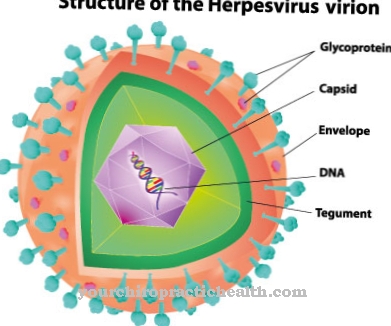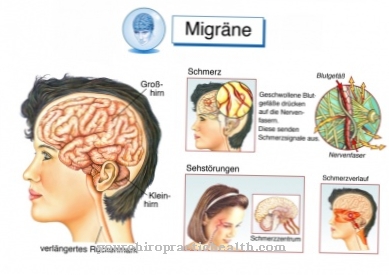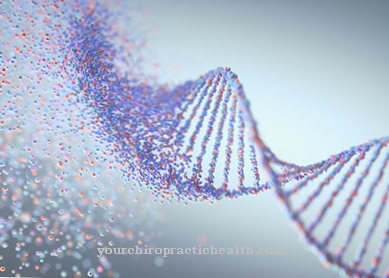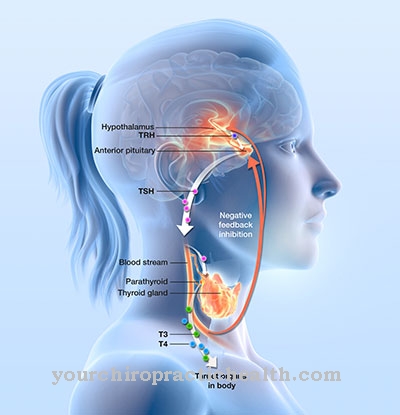Atopy is a skin disease that manifests itself as red and inflamed areas of the skin, often associated with allergic reactions and asthma. Treatment is carried out through careful skin care.
What is atopy

© Henrie - stock.adobe.com
Atopy is a very common, often long-lasting skin disease. It is a special form of allergic hypersensitivity that can include various symptoms.
These include: asthma, asthmatic allergies and chronic dermatitis. There is a known, inherited factor in atopy, so it is more common within families. The diagnosis is made by establishing typical symptoms, such as: the typical rash and a family history of allergies and asthma. In atopy, the skin becomes particularly sore and itchy, it becomes inflamed and can swell, become red, blister and oozing.
While atopy can occur at any age, it is particularly common in infants and young children. Atopy can persist into adulthood, slowly disappear, or develop into a disease that fluctuates in those affected and then subsides again.
causes
The causes of atopy are largely unknown, but the disease appears to be caused by a combination of innate and environmental factors. There seems to be a basic hypersensitivity and an increased tendency to itch and scratch.
Many examples show that atopy is related to a number of disorders such as hay fever and asthma, which many people with atopy also suffer from. Many children who show early signs of atopy are also more likely to develop asthma and / or hay fever later on.
Even if one disorder does not necessarily cause the other, they seem to be connected in some way; however, this still puzzles researchers. While emotional stress can occasionally cause symptoms, it is not the causative factor in the illness.
You can find your medication here
➔ Medicines against skin redness and eczemaSymptoms, ailments & signs
The appearance of an atopy can vary widely. Typical symptoms include excessively dry skin with reddened and inflamed areas that are associated with severe itching. Usually there is also extensive thickening of the skin. In severe cases, nodules and pustules may form that are also itchy and in some cases cause bleeding or inflammation.
If the atopy occurs in infancy, itchy reddening of the skin, possibly associated with crusts and blisters. The head and face as well as the limbs and folds are particularly affected. In small children and adolescents, the typical atopy complaints occur mainly in the joints of the joints, in the neck and on the hands and wrists.
The skin takes on a leather-like appearance and can sometimes be less sensitive to pain. The symptoms in adulthood are similar. Usually there are also very itchy nodules and accompanying symptoms. Typically, breathing problems such as asthma as well as hay fever and allergic conjunctivitis occur, depending on the causative allergen and the patient's constitution. In the further course the skin disease can develop into pronounced neurodermatitis. The development of a chronic disease cannot be ruled out.
Diagnosis & course
Atopy is usually diagnosed with a physical exam and a visual examination of skin symptoms performed by a dermatologist. Information about the medical history of the patient and their family can be helpful in making a diagnosis.
Likewise, the doctor will likely ask questions about any allergies and rashes that have occurred. A biopsy (in this case a skin sample) and a subsequent laboratory examination can also help in the diagnosis in rare cases. This also applies to analyzes of the blood, in which an increased level of certain white blood cells can be found.
Itchy skin is the most unpleasant symptom of atopy for patients, but this appears in many skin diseases and is not a compelling indication of atopy. In some cases, a doctor will also perform several examinations spaced apart in order to make an accurate diagnosis.
Complications
Various complications can arise with atopy. As a rule, the symptom is mainly connected with the occurrence of asthma and other allergic reactions and can lead to serious complaints. In many cases, this also leads to an allergic inflammation of the conjunctiva.
The asthma can be made worse by hay fever. As a rule, this severely restricts everyday life. Often there are different rashes on the skin, which first indicate an allergy. Itching occurs on the skin, which can spread over the entire body. For many people this is also a psychological burden.
Atopy is treated at home in most cases, but the doctor must provide the patient with treatment instructions. The skin needs regular care. It is important to avoid scratching the skin. This can cause wounds and scars and the atopy is only exacerbated. In most cases, with good skin care, the symptom will go away on its own and will not lead to any further discomfort.
When should you go to the doctor?
Anyone who detects hypersensitivity to certain substances should always have this checked by a doctor. Medical advice is particularly important in the case of severe complaints. If an atopy results in itchy rashes, coughing and shortness of breath or severe abdominal pain, the cause must be determined with the help of an allergy test. Severe symptoms such as severe itching or respiratory distress should be clarified and treated immediately.
If breathing difficulties and other health problems occur again and again, you should speak to your family doctor. It may be a severe allergy for which appropriate medical measures must be taken. If circulatory problems, severe shortness of breath or a collapse occur, an emergency doctor must be called immediately.
There may be a life-threatening allergic shock that needs immediate treatment. Parents who notice symptoms of atopy in their children should not hesitate to see a doctor. If the allergy is identified and treated at an early stage, major complications can usually be reliably avoided.
Doctors & therapists in your area
Treatment & Therapy
Treatment of a therapy largely consists of good cooperation between the treating dermatologist and the patient. The patient should follow his doctor's instructions meticulously for symptom relief.
Only a good understanding of one's own illness can lead to success. The most important steps in therapy therefore also include self-treatment at home and compliance with certain care measures. The skin must be kept healthy through measures. If the patient and the doctor identify direct triggers for symptoms, these circumstances should be avoided. This can successfully prevent getting lost in a "scratchy vicious circle".
For example, when it comes to skin care, it is important to use only the recommended soap and moisturizer. Frequent changes of products that come into contact with the skin can cause irritation. If necessary, the doctor may also recommend special treatment with medicinal ointments and tinctures. These often contain cortisone, one of the most effective remedies for skin inflammation.
Outlook & forecast
Atopy can be treated well in close cooperation with the doctor and taking various self-help measures into account. However, a complete and permanent healing occurs rather rarely.
In most cases, the symptoms are treatable, but recurring. In addition, numerous secondary diseases and complaints can occur, which are often chronic. For example, allergies and their physical characteristics are often considered incurable. Nevertheless, the person affected can be and remain symptom-free for a long time.
If the environmental influences change or if there is repeated contact with the irritant substance, the symptoms reappear. Over the course of their life, many patients experience an increase in the number of irritant substances and, at the same time, better use of them. In addition, due to age, the stability of the immune system and the associated self-healing powers decrease. In addition, psychological factors can influence the intensity of the illness.
With stress, going through crises or trauma, many patients experience a renewed outbreak or intensification of atopy. The patient learns to pay more attention to himself and his individual warning signals in the course of his life. This life experience is useful for him to gain symptom relief. It is possible to react early and take countermeasures.
You can find your medication here
➔ Medicines against skin redness and eczemaprevention
Since atopy is believed to be caused by a combination of genetic and environmental factors, absolute prevention is not possible. But the sufferer can contain his symptoms by taking precautionary measures. This includes taking care of the skin, e.g. he should not shower or bathe too often, too long or too hot, and the skin should also be protected from dryness.
You can do that yourself
The causes of atopy have not yet been fully researched, and the disease cannot be treated causally. However, those affected can identify the triggers for the allergic reaction and treat the symptoms.
If an allergy test at the doctor's has shown no result, patients should keep an atopy diary. In this way they can find out whether the allergic relapses correlate with the consumption of certain foods or the performance of certain activities or occur more frequently in certain life situations (for example before or after exams).
As soon as the allergenic substance has been identified, it must be avoided as far as possible. If the allergic relapses occur particularly frequently in connection with psychological stress, relaxation techniques such as yoga or autogenic training can help those affected to remain more relaxed in exceptional situations.
Antihistamines can be helpful in treating symptoms, especially if it is itchy skin eczema or hay fever. The preparations, which are available in the pharmacy as cream, drops or tablets without a prescription, primarily alleviate severe itching. Reddened, inflamed or weeping areas of the skin can be treated with medicinal zinc ointment, which must be applied two to three times a day, instead of cortisone.
Medicines containing pseudoephedrine help with allergic runny nose. In the case of allergic irritation of the eyes, vasoconstricting eye drops or rinsing with eyebright can provide relief.



























